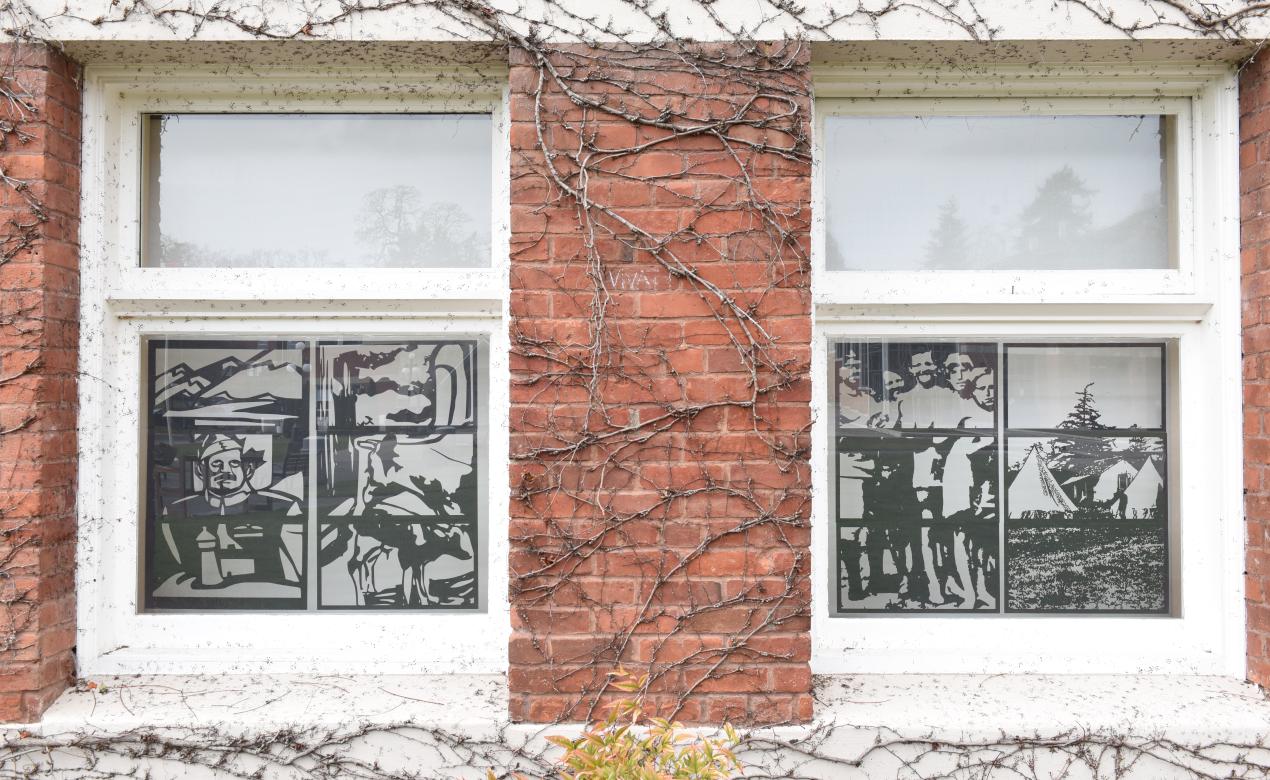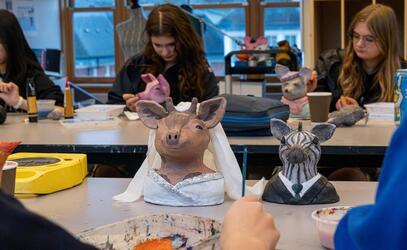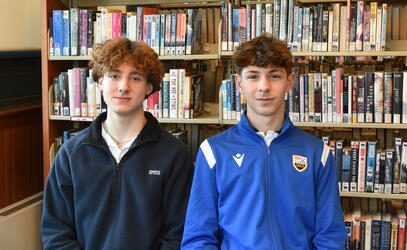
An important skill in the artistic process is collaboration with others. This is particularly true in media arts where an animation or a video game project will require many contributors, each bringing their own set of skills. For the Digital Art 11 students we try to connect with outside communities as much as possible, hoping to emulate this collaborative process.
Sometimes this takes the shape of a client-artist relationship when we have designed logos and mascots for non-profit organizations. Our yearly poster designs for the school musicals and all of the senior school music performances also fit this dynamic.
In other years our collaboration has been a bit more unusual. For instance, in 2017-18 all the students created abstract animated video segments to a piece of music. These were woven together and displayed in the Farquhar Auditorium at UVic, while the Senior School band played the accompanying music live and perfectly in sync. Another example was in 2013-14 when students became “video pen pals” with SMUS alum and neuroscientist Bechara Saab ’97, who was living in a Mars habitat simulation. The back-and-forth between Bech and the students resulted in humorous and interesting pieces of animated art exploring life in space.
Windows into History Project
Due to COVID-19 restrictions many of these collaborative opportunities have dwindled, so we were excited to be asked by Parks Canada to join the ‘Windows into History’ project at Fort Rodd Hill National Historic Site. Students were asked to create art to decorate the windows of the historic buildings and connect to the history of the place.
Designing art for a specific site carries its own challenges and cultural considerations. The students decided to focus on the military history at Fort Rodd Hill for their artwork. They applied their digital skills to enlarge and stylize historical photos from the archives, as well as some photos taken by our own Photo Club in the past year. The archival photos were provided by Parks Canada. Fort Rodd Hill is a great location for photography tours with its textured edifices, unusual tunnels and stunning backdrop. SMUS Photo Clubs have made the most of this site in years past with weekend field trips. Luckily we still had these collections of student photos to use, too.
The images the students chose fall under three broad categories that echo through the past and into the present:
The families that spent their lives every day at this beautiful site, playing, working and even rearing livestock, are now replaced with picnicking families and the dedicated employees at the park.
The service men and women who maintained this defensive point are reanimated today by volunteers, from groups like the Victoria-Esquimalt Military Re-enactors Association, who grace the facility in full military costume.
The homes, battlements, offices, tents and even the classic lighthouse, endure today as the park’s most notable landmarks.
Fort Rodd Hill sits on the traditional, unceded territory of the lək̓ʷəŋən People, known today as the Esquimalt and Songhees Nations. While the students did not attempt to recreate any cultural images from that important period, the strong black and white images they created were connected to the lineform artwork the students studied in class.
In 2017 the SMUS art teachers from all three campuses joined Bill White, a traditional elder of the Coast Salish, and artist Doug Lafortune for a workshop on teaching First Nations knowledge in art classes. The insight and knowledge they passed on to us was invaluable. In Digital Art class, the strong shapes and lines of traditional West Coast First Nations art connected well with the vector tools students were learning. Careful study was made of the line forms and how First Nations artists were using the traditional shapes in modern, digital projects.
Digitizing Historical Art
The digitizing process required the use of Adobe Photoshop to break the image down into contrasting blacks and whites that still clearly illustrated what the subject matter was. Decisions were made about foreground and background, and in many cases extra black and white needed to be digitally painted in to make a face or building easier to discern. Crucially, for the final stage to work, all black areas had to be touching for the final piece of art to be held together after it was laser cut.
These stylized images were then imported into a vector drawing application called Inkscape. The goal of this stage was to break the black and white bit-map (or pixel) image into clear mathematical lines separating the black foreground from the white. These clear lines, or vectors, would be the guidelines for the laser to follow.
We are very grateful to the Parents’ Auxiliary for helping us acquire the laser cutter which, as its name suggests, uses lasers to cut, score or emboss most materials with incredible precision.
The vectorized images for Fort Rodd Hill were laser cut into matboard to create strong black shapes with empty space, akin to the lead parts of a stained glass window. Thought was also put into filling the negative spaces in the board with colour. In the end we decided that showing the white of the buildings’ curtains brought forward the textures of the past and allowed for a higher contrast to enable better viewing.
Viewing Information
The student artwork is now on display at Fort Rodd Hill through to the end of March. You can find the Windows into History art hanging in the windows of the Warrant Officers Quarters, the Canteen, and the Lower Battery Guardhouse. These buildings would have once housed and fed soldiers working and training on site.
“Windows into History is an opportunity for students to learn about Victoria and Esquimalt’s Coastal Defence sites and history, to see the faces and learn the names of some of the soldiers and families who served and lived on site, and to interpret this history in a way that is relevant to their own interests,” says Kirby Delaney, Acting Interpretation Officer/Coordinator with Fort Rodd Hill and Fisgard Lighthouse. Some of the earliest pictures selected by the SMUS students for their artistic work date back to World War One and the interwar period. It can be challenging to build connections with this period of Canadian history. The beautiful displays created by the students help us to remember when these buildings were buzzing with activity and help teach both visitors and classrooms about these important moments in Canadian history.”
We hope you have the opportunity to visit Fort Rodd Hill to enjoy our work. It was interesting to use modern technology, like computers and lasers, to create these windows into history.


